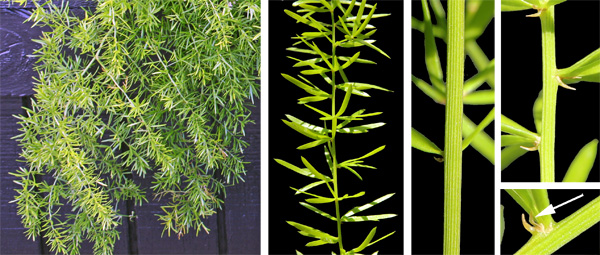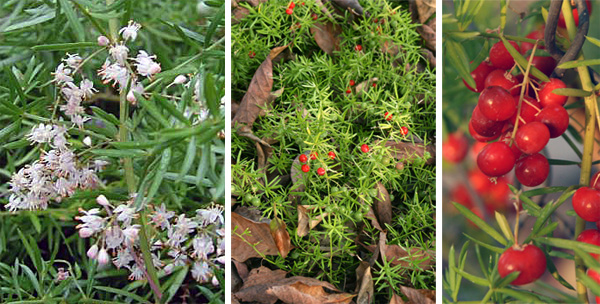
Asparagus fern is a sprawling shrub native to coastal southeastern South Africa. Despite the common name, it is not a true fern, but is in the asparagus family (Asparagaceae) or the lily family (Liliaceae, which includes plants such as amaryllis, daylilies, hosta, and tulips) depending on the classification system used. It is in the genus Asparagus, which includes the edible A. officinalis, along with about 300 other species. The exact classification of this species is a bit confused, with most references to Asparagus densiflorus, but the names A. aethiopicus, A. sprengeri, and Protasparagus densiflorus are also used as well by some.

This tender evergreen perennial with bright green, ferny foliage is commonly used as an outdoor ornamental plant or houseplant. In mild climates, it is planted outdoors as a groundcover or in containers. It is hardy in zones 9-11 but the roots will often survive to zone 7 if protected. In more temperate climates, it is used as a seasonal annual or container plant. In its native habitat, asparagus fern is found in shady, sandy sites, including coastal dunes, open rocky places and woods. Where it has escaped from cultivation, it is generally found along shady roadsides and invading woodlands or rainforests where it displaces native vegetation and prevents native species from reestablishing. It is considered an invasive weed in some locations, including Florida, Texas and Hawaii in the US.
Asparagus fern produces long, upright or trailing, branching stems sparsely covered with sharp, stiff spines in the axils. The rounded stems, up to 6 feet long, are green to brown in color and have a shallow indentation along their length. What appear to be leaves are actually leaf-like cladodes (short, flattened stems that look and function like leaves). These needle-like “leaves” arise in groups of four to eight from the nodes along the stem. The true leaves are barely visible scales near the base of the cladodes. Plants have a dense fibrous root system as well as creeping rhizomes and numerous fleshy white bulbous tubers.

Small white or pinkish-white flowers are produced in elongated clusters (racemes) along the stems from spring through fall on mature plants with sufficient light. Each flower has six tepals (3 petals and 3 sepals similar in appearance). Although fragrant, they are small enough not to be very noticeable – and plants grown in temperate climates often do not bloom. Plants are dioecious. If pollinated, female flowers are followed by small round berries up to ¼ inch in diameter. The green fruits mature to a glossy red and each contains one to three black seeds. Many birds are attracted to the fruits and are responsible for unintended seed dispersal in mild climates. The berries can cause dermatitis when in contact with skin and gastrointestinal upset if ingested and are toxic to cats and dogs.

Plant asparagus fern in full sun or light shade; plants grown in full sun are more compact and dense than those grown in shade. It does best in moist soils rich in organic matter but tolerates almost any conditions and is fairly drought tolerant once established.

Asparagus fern is valued as an ornamental for its bright green, arching stems and airy foliage. Its fine foliage gives a soft or fluffy appearance and can be used to good effect for textural contrast in combination with plants having medium or coarse-textured foliage or very large leaves. It can be planted in the ground with other annuals as a bedding plant after the last frost in cold climates. This plant makes a great filler plant in containers, especially in hanging baskets or large urns where the delicate foliage can cascade down. It has a tropical feel when combined with elephant ears, canna lilies and hibiscus. The foliage can also be incorporated as a filler with cut flowers in arrangements.
Asparagus fern is a great houseplant for novice gardeners as it doesn’t require any special care. It grows well in direct or bright indirect light (the brighter the light, the faster it will grow) and because of the tuberous roots which store water, it can tolerate periods of neglect. It does best with consistent moisture, although plants should be kept drier in the winter and any fertilization stopped during that time. The foliage will yellow and drop if the soil is too dry or there isn’t enough light. Old or yellowed stems should be cut out at the base and the ends of stems can be trimmed back to keep the plant shaped.

In the spring trim out old growth and begin fertilizing monthly for lush new growth. These plants can quickly outgrow their containers, so need frequent repotting to keep them growing vigorously. The roots are also quite strong and can break pots, so larger, thicker containers may be desireable. Repotting is best done in early spring before new growth starts. Indoor plants can be moved outdoors seasonally (bringing them back inside before frost) but should be acclimated to the stronger light outside before being moved to a spot in full sun. This plant has few pests, indoors or out, but occasionally become infested with aphids, mealybugs, spider mites or whiteflies.
Asparagus fern can be propagated from seed and division. Seeds will germinate in 3-4 weeks at room temperature. Scarify the seeds and soak in water for a day before planting to hasten germination. Plants can be separated into smaller pieces or the tubers will regenerate plants. Spring is the best time for division but these tough plants can be propagated at almost any time of the year.

The two most common varieties are ‘Sprengeri’ and ‘Meyeri’. The latter, commonly called foxtail asparagus fern, has more upright stems with denser foliage, resembling a fluffy animal’s tail, radiating outwards from the center of the plant. This cultivar is especially nice as an upright focal point in the ground or a container surrounded by lower plants. It does not produce seed as readily as the species so does not have the same invasive potential in mild climates. ‘Cwebe’ has graceful, upright, arching stems and copper-colored new growth. It does best in light shade. ‘Sprengeri Nanus’ and ’Sprengeri Compacta’ are more compact forms.
– Susan Mahr, University of Wisconsin – Madison
Ask Your Gardening Question
If you’re unable to find the information you need, please submit your gardening question here:





 Marigolds
Marigolds Create a Butterfly Garden
Create a Butterfly Garden Plant Flowers to Encourage Beneficial Insects
Plant Flowers to Encourage Beneficial Insects Forcing Bulbs
Forcing Bulbs


